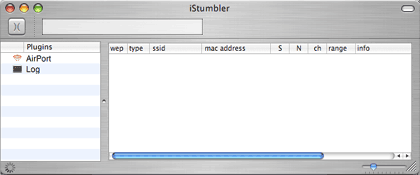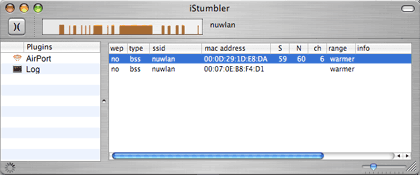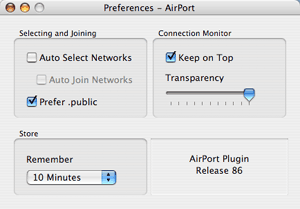Review: iStumbler 86
I’ve always tried to avoid being that geek with the wireless network-sensing keychain. I spend a lot of time with my 15" Titanium PowerBook, and when I’m in an airport bar or a downtown cafe it’s nice to have Internet access, but unfortunately I don’t always know whether there’s an open wireless network available.
Enter iStumbler, stage left.
It is not part of some mega-suite that does lots of neat things. It does one thing, and one thing only: it seeks out and finds wireless networks for Mac OS X users, informs you of their status and signal strength, and, if you want, joins them for you.
Note that this is not quite the same as using the AirPort status menu, insofar as it scans, gives a more useful signal readout, and will sometimes show networks not visible under the AirPort menu.
Aside from one presumably easy-to-fix but frustrating flaw, it performs all of its functions supremely well and reliably. So I can avoid being “that guy with the keychain.” Unfortunately, that flaw is accompanied by some user interface decisions and a lack of documentation that show it needs some polish yet before it can be useful except as a quick network-finder.

iStumbler’s main window, with no networks visible.
The main window (see picture) has room for lots of useful information about the network you’re attempting to join. Unfortunately, I have not been able to figure out what some of them do, as I have yet to see any information included in them (for instance, “location”).
There’s also room for expansion in the form of other plug-ins; at present, there is a GPS-receiver module also available. As I don’t own a GPS receiver of any kind, I was unable to test it, but the documentation on the Web site suggests that it should work just fine.

iStumbler’s main window, with networks visible.

iStumbler’s main window, after joining a network.

iStumbler’s connection monitor.
Note that there is plenty of useful information available in the main window when there is a network to be found: whether WEP is in use or not, if “yes” then what type, the network’s SSID, the router’s MAC address, the channel, and other information. The documentation does not say what “S” and “N” are, and I was unable to find out otherwise. (I’m sure an e-mail to the developer could resolve the question, but that demonstrates the lack of polish I mentioned a moment ago.)
Once you join a network, it also shows you a signal strength graph of the network over time. The graph isn’t configurable in the preferences, but I imagine the time interval will be in a future version, as that’d be helpful. iStumbler will also pop up a connection window. The preference for changing the transparency of the window didn’t work, but I was able to use the window in its fully opaque state.
The network information readout became quite useful when I was at a cafe and discovered two wireless networks. The system AirPort menu could not tell me anything about the networks, but iStumbler told me which one was open and what the signal was like. It uses a descriptive and relative measure (“warmer”, “cooler,” etc.) for strength of signal; I am undecided as to whether this makes sense or not, being used to percentage strength.
Just like the signal strength metaphor, iStumbler’s less-than-fantastic interface sometimes gets in the way of more meaningful functionality. For instance, the Join button’s icon is the warchalking symbol for “open network,” which is a tad…odd, to say the least, as the two aren’t quite the same thing. There is a slider in the lower right that’s not documented anywhere and which has no apparent function; it seems to lack a programming hook in the nib file, and to add insult to injury it has no tooltip either. And, of course, iStumbler uses a metal window, which I think represents a violation of the HIG.
To give it the benefit of the doubt, iStumbler does its job quite well for the mythical power user who already knows lots about wireless networking. Unfortunately, I know a fair bit and I don’t think I have any idea what some of it does, defying the open-source credo that a user interface should at least be obvious to someone who knows what he’s doing.
There were some other minor problems I experienced while using iStumbler, some places where a little polish was still needed, in addition to one major flaw. I was unable to consistently register with a network using the Join button, and yet I never had any trouble when using the system menu. The Log plug-in doesn’t appear to do anything useful, as far as I can tell, and not all of the interface elements line up, something a minor nib hack could fix easily.
Moreover, each plug-in has its own preferences, which would be perfectly reasonable except that which plug-in’s Preferences window is brought up depends on which plug-in is selected in the main window. That’s a surprising behavior; only as I was taking the screen shots for this review did I discover that particular bug (or “feature”).
Most egregious were the Auto Select Networks and Auto Join Networks features. I never could figure out just what Auto Select did on its own, but in combination with Auto Join, it consistently managed to drop my connection and then crash my AirPort driver so that the card stopped responding until a reboot. Turning that off seemed to fix the problem.

iStumbler’s AirPort tool preferences.
It’s a shame that iStumbler still suffers from some truly painful interface decisions, because it’s a powerful tool and does exactly what it claims to. As it’s an open source project, I’m working on a new interface for it that should perform precisely the same functions without the shortfalls that are bothering me.
At any rate, if what you want is a quick window into all the available wireless networks, don’t mind a questionable interface, and don’t want to feel like the geek with the keychain WiFi network finder, iStumbler may be the perfect tool for you. It can tell you everything you want to know about the networks, including the channel and SSID, and it can even join the network for you.
Hopefully iStumbler become more polish before long, and then I can recommend it unequivocally; for the moment, if you want something a little simpler, suck it up and get the keychain.

Reader Comments (10)
iStumbler Release 89 updates the plugin interface to support logging and other cross-plugin communication, and improves the Log plugin which can now selectively display notifications based on user preferences.
Download
Add A Comment